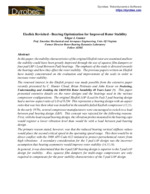Papers
“Ekofisk Revisited – Bearing Optimization for Improved Rotor Stability,” |
Abstract
In this paper, the stability characteristics of the original Ekofisk rotor are examined and how
the stability could have been greatly improved through the use of squeeze film dampers or
four pad LBP (Load Between Pad) bearings. The emphasis of the study is directed towards
the bearings and how they effect the rotor stability. The previous papers written on Ekofisk
have mainly concentrated on the evaluation and improvement of the seals in order to
increase rotor stability.
The renewed interest in the Ekofisk project was made possible from the extensive paper
recently presented by C. Hunter Cloud, Brian Pettinato and John Kocur on Predicting,
Understanding and Avoiding the EKOFISK Rotor Instability 40 Years Later (9). This paper
presented extensive details on the rotor designs and the bearings used in the various
compressor configurations. The original Ekofisk LOP (Load On Pad) 5 pad bearing design
had a narrow aspect ratio of L/D of 0.284 This represents a bearing design with an aspect
ratio that was less then what was installed in the unstable failed Kaybob compressor (12,21).
In the early 1970s, several compressor manufacturers were encouraged to switch to a load
between pad bearing design (LBP). This concept was rejected for the following reasons.
First, with the load on pad bearing design, the vibration probes mounted in the bearing caps
would register a lower vibration level than would be with a load between pad bearing
design.
The primary reason stated, however, was that the reduced bearing vertical stiffness values
would place the second critical speed in the operating speed range. This then would be in
direct conflict with the 1969 API Code 612 initiated to protect petrochemical rotors from
high vibrations. A secondary consideration for the 5 pad LOP design was the incorrect
assumption that bearing asymmetry would improve rotor stability (14,15,18).
In general, it was determined that the 4 pad LBP bearing design is superior to the 5 pad LOP
design for stability. Also, squeeze film dampers for multi-stage compressors are only
required to compensate for the poor stability characteristics of the 5 pad LOP design.

